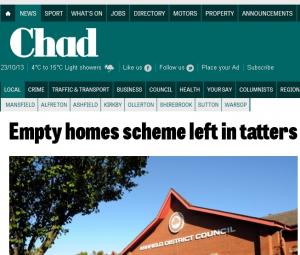



In a widely-reported story, Ashfiled District Council has walked away from a £3.5million allocation under Round 1 of the HCA Empty Homes Programme, citing contractual issues that could not be resolved.
Ashfield is not the only Council to cite difficulties with the HCA contract and not the only provider to hand its money back. But this is likely to be the biggest amount so far.
Trevor Watson, Service Director for Economy, was reported on the Mansfield and Ashfield Chad website to have said:
Unfortunately the draft contract was not made available until late 2012. Legal advice then confirmed that the outline terms and conditions of the contract were unacceptable to the council as it placed a financial risk with the authority if at any stage within the life of the programme, the landlord defaulted on the lease .... Despite protracted discussions, the HCA were not willing to re-negotiate the contract to sufficiently mitigate the risk that lay with the council.
The HCA is apparently offering a substitute allocation of £400,000 for purchase and repair of empties. Presumably any contractual difficulties with this alternative arrangement have been smoothed out as they seem to have related in part to the council's ongoimg exposure to the actions of the owner in the leasing model.
The original allocation was reported to be for the delivery of 285 empty homes. The revised allocation is said to be for 20.
Where the story becomes less straightforwad is that the original allocation and target were (according to a source at Ashfield District Council) not for Ashfield alone but also for Mansfield District Council and Newark and Sherwood District Council . Ashfield were the lead partner and when the other councils pulled out Ashfield seems to have been left holding the baby. At the time of writing clarification is awaited as to the numbers of units that were expected to be delivered in the other two districts.
Given the delay in issuing contracts and the infexibility around the 2015 deadline (attributable to the HCA and the government respectively) the 285 target would always have been demanding one to achieve. But the scheme model as reported by the Mansfied and Ashfield Chad does not seem well-configured to attract large numbers of owners:
The council would have funded 50 per cent of the cost of the work needed to bring it back into occupation, with the landlord paying the other half up front.
Repairs would have been administered by the council and the work would have been subject to the landlord entering a 10-year lease agreement with the council, ensuring the property was then rented out.
The length of lease and need for up-front contribution by the landlord (indeed any contribution by the landlord) would all seem likely to decrease the amount of interest in the scheme.
Funding programme still intact
Meanwhile, Caroline Cormack of the Homes and Communities Agency has confirmed to us that where providers are handing money back it is remaining within the Empty Homes programme and being reallocated to those able to spend it: the scale of the funding programme is not reducing.
However it is clear from the Ashfield case and from the results of Round 2 bidding that there is a strong move away from leasing and towards Purchase and Repair, involving much larger amounts of grant per unit. This will mean a signficant reduction in numbers delivered and it is notable that recent statements by HCA refer to meeting their target of 3,300 (as originally stated in 2010) rather than the much higher numbers reported when the grant allocations were made in the Spring of 2012. (The 3,300 target was for the £100million, therefore including the Community Grants Programme administered by Tribal).
